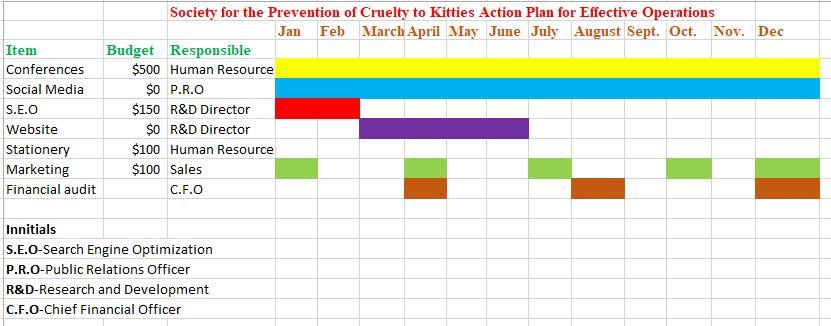Research
Background
Pets play a crucial role in people’s lives and must be protected from factors that endanger them. Population control is quintessential to ensure cats receive optimum care. Spading and neutering cats help improve their quality of life (Phillips et al., 2018). Other than preventing accidental littering of kittens in society, the medical procedure helps prevent testicular cancer. The procedures help to reduce the animals’ desire to roam around for mates. Subsequently, the risk of injuries from fights is also reduced as neutered cats hardly roam around (O’Haire et al., 2018). The increased number of stray cats in the community jeopardizes their quality of life.
Situational Analysis (Internal)
The Society for the Prevention of Cruelty to Kitties (SPCK) has been working for many decades to improve cats’ lives. SPCK relies on donors to help in raising funds to take care of the animals. The organization have been facing challenges due to reduced donations and negative reviews. Further, it has suffered criticism after reducing the time for stray housing animals. The management must therefore restore donor confidence by operating within the donors’ and community’s expectations.
Situational Analysis (External)
Awareness of animal protection laws has intensified as the government, through its relevant agencies, has announced them and urged people to protect animals. Consequently, the process of taking care of stray animals is known, and people are in full support of initiatives centred on animal protection. Donors expect accountability for all the funds they raise for animal welfare. Compliance policies must be met to be licensed to take care of animals. The awareness in the community is low, and donations are shrinking, which impacts the project’s sustainability.
SWOT Analysis for the Society for the Prevention of Cruelty to Kitties (SPCK)
Analyzing the strengths, weaknesses, opportunities, and threats is key to informing management on the best decisions regarding the organization’s status. Table 1 below shows SPCK’s SWOT analysis.
Table 1. SWOT Analysis
Analysis
Communication Objectives
- To increase awareness of cats’ spading and neutering.
- To restore donor confidence.
- To reach a consensus with the stakeholders on time taken between when cats are taken into when they are adopted.
Stakeholders
The primary audience for the communication is community members and donors.
Community Members
Table 2. Community Members
Donors
Table 3. Donors
Other Stakeholders and Groups for Consideration
- Pet owners-The people who own pets need to be reached for information on the best ways to treat cats.
- The local media-The media outlets need to know crucial information because they interact with the local community and will therefore be easy to convey information.
Vulnerabilities, Opportunities and Strategies
Vulnerabilities
- The organization has a bad reputation due to changes in caring for cats.
- A shortage of donors leads to low finances to run the organization.
- Poor awareness of the organization’s programs.
Opportunities
- Media coverage is likely to improve the organization’s reputation.
- The employment of a Public Relations Officer (P.R.O) will likely make the organization reach out to more community members.
Strategies
- Increasing the number of conferences to increase public awareness.
- Improvement of donor relationships to increase financing.
- Public meetings to improve the relationship with cat owners.
Communication
Key Messages
- You must all register your pets with our organization so that we can follow up on their health status and train you on the trending methods of catering for cats.
- Our safety plan for all stray cats is assured as the time taken before adoption will be increased indefinitely, and cats will be cared for until it is adopted.
- The organization will update all the funds to ensure donors know the expenditure and plan.
- SPCK is dedicated to improving cat’s life and calls upon all stakeholders to reach out through our contacts in case of any questions and concerns.
Tactics
- Periodic conferences-Holding discussion forums with the stakeholders are vital in ensuring they have the message required to keep the cats safe. SPCK will hold conferences with stakeholders monthly to ensure that the cats are safe in the community. Periodic financial audit-Donors are motivated when their donations are used to meet the desired goal. The commitment to producing financial reports helps to increase donor confidence. The chief financial Officer (C.F.O) is responsible for preparing the quarterly financial audit to ensure no money is lost.
- Increasing online presence-Leveraging the social media technology is critical to ensure close contact with people. The online presence will include search engine optimization (SEO), marketing, and collection of feedback for the organization to make the popular decision.
Action

Evaluation
The effectiveness of the plan will be measured by:
- Increased number of cats being spade and neutered through monitoring the register of the cats undergoing the medical procedure.
- Increased the number of donors through conferences and donor parties by analyzing the organisation’s attendance list for conferences and visitors.
- The plan will be monitored using the attendance register on conferences and visitors coming to the organization to learn about the cats’ safety measures. A register of all cat owners and community members will be maintained, and the success will be evaluated through the increasing number of participants.
References
Phillips, S. C., Hedge, Z., & Peralta, J. M. (2018). The role of private practitioners in reducing the numbers of homeless dogs and cats and shelter euthanasia rates. Journal of the American Veterinary Medical Association, 253(4), 404–408.
O’Haire, M. E., Bibbo, J., Hoffman, C. L., Mueller, M. K., Ng, Z. Y., & Buechner-Maxwell, V. A. (2018). Overview of centres and institutes for human-animal interaction in the United States.Human-Animal Interaction Bulletin, 2018.